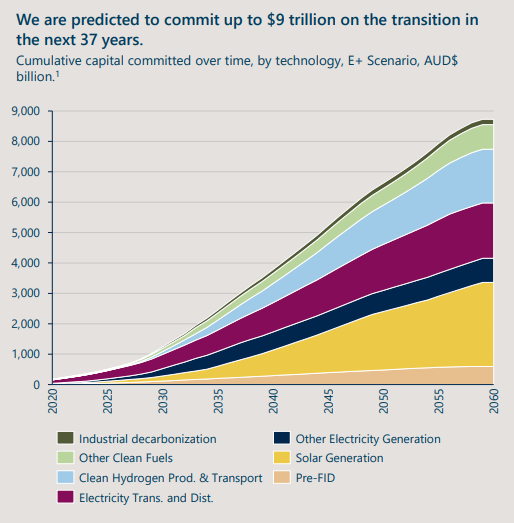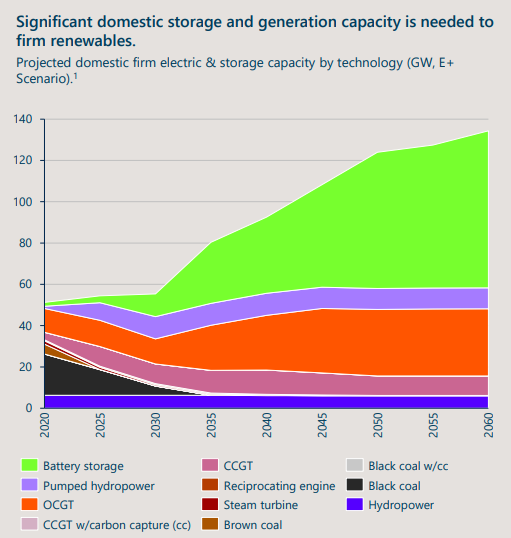Anyone who thinks attaining Labor’s 82% Renewable Energy Target (RET) by 2030 is feasible or affordable is kidding themselves.
To meet Labor’s fantastical target, much of Australia’s baseload coal generation—the backbone of the country’s energy grid—would have to be shut down and replaced with masses of intermittent and weather-dependent wind and solar generation, backed up by ginormous amounts of battery and pumped hydro storage.
Even if the RET were achievable, the costs of getting there would be enormous.
According to a July 2023 report from Net Zero Australia (a consortium from the University of Melbourne, University of Queensland, Princeton University, and management consultancies Nous and Evolved Energy), the cost of meeting the 82% RET would be $1.2 to $1.5 trillion by the end of this decade, with $7 trillion to $9 trillion in capital required by 2060 to meet Australia’s goal of net zero by 2050.

Source: Net Zero Australia
Much of this predicted cost is attributed to the huge amounts of storage required to offset the inherent intermittancy of wind and solar:

Source: Net Zero Australia
The intermittency of renewable energy is especially noticeable in the winter, when solar generation is low and there are typically long periods of low wind.
The Snowy Hydro 2.0 pumped hydro project is a microcosm of the cost and difficulty of achieving the ‘net zero’ fantasy.
Snow Hydro 2.0 aims to use surplus renewable energy generated during the day (mostly solar) to pump water up to an elevated reservoir, which is then released at night or during wind droughts to provide hydroelectricity when renewable generation is unavailable.
The cost of Snowy Hydro 2.0 has skyrocketed to unimaginable levels.
The former Turnbull Coalition government initially announced that the project would cost $2 billion and be finished by 2021. The government increased the cost to $6 billion, then $12 billion by 2023.
Problems persist, however, with Snowy Hydro 2.0 still under construction and years behind schedule. As a result, taxpayers are facing further cost blowouts and delays.
Snowy Hydro chief executive Dennis Barnes last week indicated that the cost blowout is so great that it will take 9 months to fully quantify.
“We have gradually come to the realisation, and then quickly come to the realisation that we’re not going to achieve the schedule at target cost of $12bn”, Barnes said.
“We need some time to do a proper analysis of what the final cost will be, but it was clear as we were finalising our annual report that we weren’t going to be able to achieve the $12 billion”.
Snowy Hydro admitted productivity improvements have not been delivered as expected, and the project can no longer absorb the costs associated with the “geological challenges”, which have ranged from rock too hard to penetrate to land too soft to drill.
To add salt to wounds, Snowy Hydro 2.0 will be linked via the 365-kilometer HumeLink in southwest New South Wales. This ‘green’ project is also behind schedule, and the estimated cost has risen to about $5 billion.
HumeLink was originally pitched at $1.3 billion by Transgrid before official estimates put it at $3.27 billion in 2021 and then $4.88 billion in 2024, when its carrying capacity was also reduced from 2.6 gigawatts to 2.2 gigawatts.
While construction on HumeLink has finally commenced, it has it has not yet secured all its landowner agreements.
Some critics, like Victoria Energy Policy Centre’s director Bruce Mountain, estimate Snowy Hydro 2.0 could cost up to $20 billion—a blowout of 900%.
Others, like Graham Bradley, a former chairman of EnergyAustralia and of HSBC Bank Australia, warn that Snowy Hydro 2.0’s delay could thwart the broader renewables rollout, as well as drive up consumer electricity costs.
“The continued delay and high cost of the project is a serious setback to the energy transition because the system has become so dependent on the backup from Snowy 2.0 for future planning purposes. It is hard to fill that gap”, he said.
“There’s another two-plus years at least [of construction] plus all the transmission, so it’s going to be very hard to backfill that in the time that is required without a negative impact on electricity prices across the east coast”.
As acknowledged over the weekend by renewables fan site Renew Economy, “transmission projects across the country—like all civil construction projects—are being hit by cost increases caused by rising global demand, supply chain disruption, and increased prices for raw materials”.
“The cost of Project EnergyConnect also jumped from $2.23 billion to $4.1 billion”.
“AEMO has admitted that future transmission plans may have to be rethought, given the average 50% increase in costs”, Renew Economy reported.
The estimated cost of the 2,000-megawatt QLD Borumba Pumped Hydro project has also increased by $4.2 billion to $18.4 billion, with completion not expected until 2033 at the earliest. As with Snow Hydro 2.0, costs are certain to rise.
Snowy Hydro 2.0 and Borumba are only microcosms of the astronomical costs of the renewable ‘revolution’.
Pumped hydroelectric projects create no net power. They simply serve as storage vehicles for excess renewable energy generation (mostly solar) throughout the middle of the day.
Battery storage and a distributed network of solar and wind turbines with transmission lines scattered throughout the countryside are also very costly.
Weather-dependent energy is fundamentally unreliable. It is also prohibitively expensive due to the extensive infrastructure, transmission, and storage requirements, as well as the need to keep dispatchable hydrocarbon generators on standby for when wind and solar power fails.
As a result, Australian customers are facing increasing energy costs, both directly on their bills and indirectly through taxes to fund renewable energy subsidies and projects like Snowy Hydro 2.0.
Policymakers should stop gaslighting and be transparent about the immense costs and trade-offs associated with Australia’s renewable energy transition.

